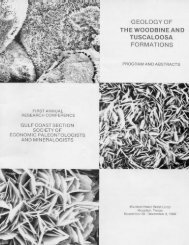Petroleum Systems of Deep-Water Basins - Gulf Coast Section SEPM
Petroleum Systems of Deep-Water Basins - Gulf Coast Section SEPM
Petroleum Systems of Deep-Water Basins - Gulf Coast Section SEPM
You also want an ePaper? Increase the reach of your titles
YUMPU automatically turns print PDFs into web optimized ePapers that Google loves.
The <strong>Petroleum</strong> System <strong>of</strong> the Western Atwater Foldbelt<br />
in the Ultra <strong>Deep</strong> <strong>Water</strong> <strong>Gulf</strong> <strong>of</strong> Mexico<br />
Michael G. Moore<br />
Gillian M. Apps<br />
Frank J. Peel<br />
BHP Billiton <strong>Petroleum</strong> (Americas) Inc.<br />
1360 Post Oak Blvd., Suite 150<br />
Houston, Texas 77056 USA<br />
e-mail: mike.g.moore@bhpbilliton.com<br />
e-mail: gillian.apps@bhpbilliton.com:<br />
e-mail: frank.j.peel@bhpbilliton.com<br />
Abstract<br />
Recent major discoveries at Mad Dog, Atlantis, and Neptune have demonstrated a working petroleum system in<br />
the western Atwater fold belt (WAFB). Understanding the nature and scale <strong>of</strong> the petroleum system is important in<br />
determining an appraisal strategy for the discoveries and for pursuing other exploration opportunities.<br />
The source interval in the western Atwater fold belt is interpreted to be Upper Jurassic to Lower Cretaceous carbonates<br />
and marls. Hydrocarbon generation and migration began in the Upper Miocene and continues to present day.<br />
Hydrocarbon reaches the structural traps by a combination <strong>of</strong> vertical and carrier bed migration.<br />
The traps in the western Atwater fold belt are very large, salt-cored, compressional anticlines cut by both normal<br />
and reverse faults. These structures began to form in the upper Miocene and growth continued through the Pliocene.<br />
Erosion <strong>of</strong> the growing structures removed varying amounts <strong>of</strong> the Miocene section. There is generally less erosion to<br />
the southwest and increasing depth <strong>of</strong> erosion to the northeast.<br />
The reservoir rocks in the western Atwater fold belt are lower and middle Miocene submarine fan lobes deposited<br />
at or near the base <strong>of</strong> slope. Pre-existing structural and depositional topography controlled sand deposition. The fan<br />
lobes display a compensational stacking pattern and the reservoir sands are interpreted to be amalgamated and layered<br />
sheet sands. Interbedded Miocene shales seal the reservoirs.<br />
23

















